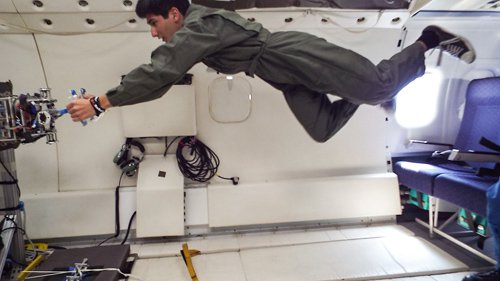
A test engineer attached to a test surface via the gecko-like adhesive, during zero-gravity airplane testing.
NASA’s Orbital Debris Program Office estimates that there are over 20,000 pieces of orbital debris around the Earth, and that they are traveling at over 22,000 mph. These pose a threat to existing space assets. In 2009 a dead Russian satellite accidentally smashed into a U.S. communications satellite creating even more pieces of space debris.
In this task, we have been inspired by geckos to try and address part of the issue. Geckos are nature’s most amazing climbers, with incredibly intricate adhesive structures on their feet. These microscopic foot hairs use van der Waals forces to stick to almost anything from glass to tree bark. Geckos can also turn the stickiness ON and OFF with a slight motion of the foot. We are now making hairy grippers that could stick to and capture a piece of space garbage that might be tumbling uncontrollably in a dangerous orbit. The adhesive works on over 30 different kinds of spacecraft surfaces, and it has been tested in a vacuum chamber at the cold temperatures of space. We recently tested these grippers in NASA’s zero-gravity airplane. In zero gravity, we grappled floating targets, manipulated them, and then let them go with near-zero force. System-level tests on an airbearing floor are being performed with 350 kg floating robotic spacecraft in JPL’s Formation Control Testbed.
People on this Task
Vladimir Arutyunov


